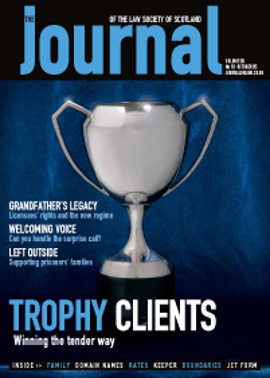Book reviews

EDITORS: BLEXTOON AND VAN BALLEGOOIJ
PUBLISHER: TMC ASSER PRESS
ISBN: 90 6704 181 5
PRICE: £50
The Extradition Act 2003 established a system under which each of the UK’s extradition partners is in one of two designated categories. Category 1 territories are covered by the Council Framework Decision of 13 June 2002 on the European arrest warrant (“EAW”) and the streamlined surrender procedures between member states. The Framework Decision is not directly applicable in the Scottish courts, but it seems certain that the courts will keep it in mind in interpreting Part 1 of the Act – a task they increasingly face. A “Handbook” on the EAW, purporting to serve “as a guide to the judiciary and other interested parties”, is therefore an attractive prospect, especially when supported by a website, www.eurowarrant.net.
However this is not a “handbook” in the practical procedures sense. Although the Framework Decision is reproduced with annotations, these are rather brief and the bulk of the book is a collection of more or less academic papers dealing with the origins and significance of the instrument. Some of those are masterly: Professor van der Wilt’s chapters on Reciprocity and on Ne Bis in Idem are especially helpful, and so is Professor Lagodny’s consideration of the concept of surrender (as distinct from traditional extradition). But this material is likely to be more directly relevant to the academic and international lawyer than the criminal law practitioner.
Other contributions are of more doubtful value. It is, for example, disappointing that the chapter by Paul Garlick QC on the EAW and ECHR focuses much more on English case law than on that of the Court of Human Rights. This contributes to his fundamental error in treating it as a given that the fair trial rights in article 6 “are engaged in the process of executing the EAW”. Caroline Morgan, in her otherwise useful chapter on defendants’ rights, makes the same mistake. The Strasbourg court has explicitly stated that article 6 does not apply to extradition proceedings because they do not determine either criminal charges or civil rights and obligations (Mamatkulov v Turkey (46827/99 and 46951/99, Chamber judgment, 6 February 2003; Grand Chamber, 4 February 2005), as Nico Keijzer recognises in his contribution from a Dutch perspective.
Mamatkulov did accept that a country proposing to surrender a fugitive must give proper consideration to the possibility that there will be a “flagrant denial of justice” and hence a breach of article 6 in the requesting state. Garlick devotes most attention to this aspect, but nowhere recognises that the Strasbourg court has set the bar extremely high. It is, therefore, difficult to see the basis for his expressed hope that UK courts “will give section 21 of the Extradition Act 2003 [judge at extradition hearing must consider ECHR compatibility] a wide interpretation”. As Selma de Groot points out in her chapter, extradition arrangements between states depend on mutual trust in each other’s laws and in the way these are executed. Unless the assessed risk of a breach of article 6 at trial would make out an application in Strasbourg, for the UK courts to refuse surrender on this ground would simply place the UK in indefensible breach of its international obligations.
Since 9/11, terrorism has driven international criminal justice policy. The Framework Decision mentions “terrorism” only as one of the offences to which the EAW applies without verification of double criminality. One obvious reason is that in practice, after a terrorist act, one might expect to see a charge such as murder as the principal charge against the accused. Moreover, Commissioner Vitorino, in his Introduction to the Handbook, explains that “replacing the traditional extradition process by a surrender mechanism based on the concept of mutual recognition and, in a sense, of free circulation of judicial decisions, was part of the mutual recognition programme drafted by the Council in November 2000”. The Commission had almost finished work on the proposed EAW when the 9/11 attacks took place; the need for an effective response “merely resulted in speeding up the process”. Terrorism as such is not dealt with in the Handbook.
The Handbook is, then, something of a curate’s egg. As a collection of papers and contribution to the literature, it is extremely valuable. It serves, too, as a good starting point for understanding the issues which underlie the EAW. But it needs to be read critically. As a guide to procedure it is of variable quality and placing uncritical reliance on everything it contains would be unsafe.
Alastair N Brown, Solicitor Advocate
In this issue
- Back on the home front
- Exchanging the "missive"
- Perfect pitch
- Tales from the court
- The going rate
- Licence please
- "Your call is important to us..."
- Wake up to .eu
- Know your boundaries
- Outside in
- Checks and balances
- Policy and practice
- Supporting credentials
- Infrastructure: who pays?
- Protective awards unprotected
- Website reviews
- Book reviews
- New terms for old
- Keeper's corner






